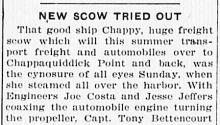Near Chappaquiddick Point lies an unassuming summer house with a big mission. Over the last summer, the Martha’s Vineyard Shellfish Group has converted the two-bedroom home into a shellfish nursery complete with swirling pools of saltwater and millions of baby bay scallops. And although the project is not yet complete, the hatchery has already helped raise millions of tiny shellfish for distribution to the Island’s coastal ponds.
Its broader mission is training future aquaculturalists. Already 17 commercial fishermen on the Vineyard are well on their way toward becoming sea farmers. “Nine of the 17 have already applied for aquaculture leases in Gay Head, Edgartown and Oak Bluffs,” Mr. Karney said.
The shellfish hatchery is now teaching Vineyard fishermen how to raise their own shellfish for market. This is a new mission. In the past, the hatchery had only enough resources to deliver baby shellfish for broadcasting in the Island ponds. But early this year, with the help of federal grants, the Martha’s Vineyard Shellfish Group embarked on an extensive training program to educate Vineyard commercial fishermen in the new waterfront science. These are fishermen who were dislocated by the collapse of the offshore fisheries in the last year.
The expansion of the shellfish group’s role in the community and the construction of the new hatchery are being funded by several grants from the National Marine Fisheries Service totalling a half a million dollars. The group is being assisted by the Martha’s Vineyard Land Bank, which is allowing the use of the house and the three acres formerly known as the Lamb property. The group has also obtained volunteer assistance.
Richard (Rick) C. Karney, 44, shellfish biologist and director of the shellfish group, has had a view to the future since he started the shellfish hatchery in 1980 at Lagoon Pond. Every year he has turned out millions of baby bay scallops and quahaugs for the Island’s participating towns. He said it has always been his goal to see aquaculture take a larger role in the community. In the years ahead, increasingly more commercial shellfishermen will begin raising their own. They’ll do it below the surface of the water in aquaculture lease sites.
With the decline of groundfish stocks on Georges Bank and in other waters south of the Vineyard, the federal government set up grants to organizations that could help fishermen find another livelihood on the waterfront. Mr. Karney applied last fall and in the first phase received $189,000 from the fishing industry grant program of the National Marine Fisheries Service. Together with another $50,000 from a similar program on Nantucket, the shellfish group entered into an agreement with the Martha’s Vineyard Land Bank and the old summer house was leased for three years. A training program was begun for 17 commercial fishermen. Mr. Karney and his staff of three people have been training with great success. Next year, the shellfish group begins a second phase program which will help the local fishermen acquire the necessary equipment to begin on their own. The second phase grant, $311,000, provides the startup capital for the purchase of seed and culture equipment.
In the meantime, the hatchery continues to produce the bay scallops and quahaugs that the Island’s participating towns need each year to seed their ponds.
Already the hatchery has delivered 5 million quahaugs to the Island participating towns this year, approximately the same as last year. The hatchery will be two weeks behind in its delivery of between 5 and 6 million bay scallops to the Island’s participating towns. In 1994, the hatchery delivered 7.5 million bay scallops. Mr. Karney concedes the numbers are down slightly from last year. This has been a year of transition, a year of dramatic change for the shellfish group. But the prospects for the future with the shellfish hatchery will get better.
The new shellfish nursery on Chappaquiddick has doubled the size of the hatchery. Next year Mr. Karney has the option at either extreme of raising twice the number of shellfish or holding onto the shellfish longer to insure of their survival. But most likely, there will be a little bit of both.
The expansion of the shellfish hatchery has not cost the Island towns a dime more. In 1980, the shellfish hatchery was built with the help of federal grants, at a cost of $100,000.
For Gabriella Castro, a former commercial fisherman, and one of the three trainers at the hatchery, the expansion of the shellfish group could not have come at a better time. There is no possible way the shellfish group could have expanded its overcrowded facilities on Lagoon Pond. The new relationship that has arisen with the Martha’s Vineyard Landbank on Chappaquiddick has made growth possible without the debilitating costs associated with buying land. “Do you have any idea what it would cost to purchase waterfront land for a hatchery?” she asked.
“This is a massive capital project for us. We’ve essentially doubled our facilities,” Mr. Karney said.
And while the numbers of shellfish are off for this year, Mr. Karney is optimistic about delivering more shellfish to Island ponds in the years ahead. Mr. Karney said he sees the Lagoon Pond facility as a place where shellfish will be spawned and fed. The nursery on Chappaquiddick will be used as a holding area for shellfish before their release.
Mrs. Castro sees the new role of the shellfish group in broader terms than just helping fishermen this summer and next -- it is building a bridge where one had not existed before. “There has always been a gap between the Martha’s Vineyard Shellfish Group and the fishermen,” she said. The fishermen have been suspicious of the scientists. Many New England fishermen have looked at aquaculture with suspicion. Now perceptions are changing.
“This year is special,” she said. Fishermen have been drawn into the science. They are learning to do much of the work on their own. “The fishermen are excited about the prospects. We are closing the gap.”









Comments